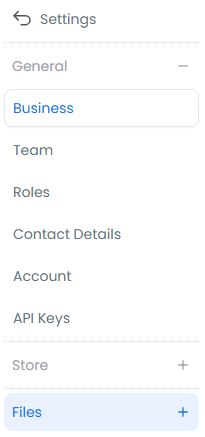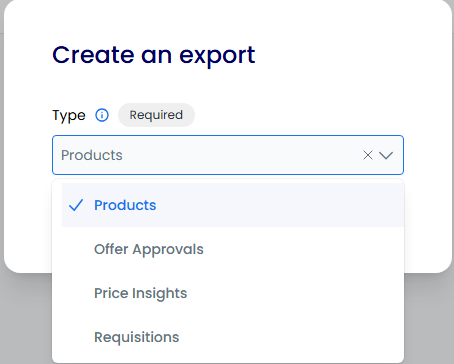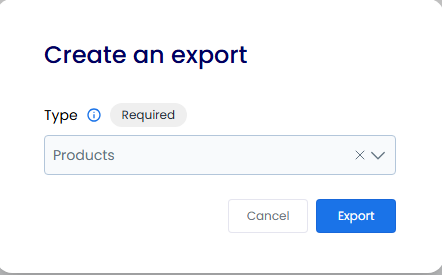Exporting Files
Learn how to efficiently export and manage various types of data files to optimize your business operations and decision-making processes.
Overview
The file export feature empowers you to extract and analyze your business data effectively. By providing comprehensive data access and management capabilities, this tool becomes essential for making informed business decisions and maintaining efficient operations.
Key Capabilities
Transform your data management with:
- Standardized Exports: Ensure consistency across your organization with uniformly formatted data files that simplify analysis and reporting
- Comprehensive Coverage: Access a wide range of data types to support various business needs, from inventory management to financial reporting
- Historical Access: Maintain complete records of past exports, enabling trend analysis and audit compliance
- Custom Extracts: Create tailored exports that match your specific business requirements and reporting needs
- Efficient Processing: Generate large data sets quickly, saving time and resources while maintaining data integrity
Business Impact
Regular data exports enable you to:
- Make data-driven decisions based on comprehensive business information
- Streamline reporting processes through automated data extraction
- Maintain accurate records for compliance and auditing purposes
- Share standardized information across teams and departments
- Track business performance through consistent metrics
Exporting Files
Navigation and Access
- Settings Access
Begin your export process with these strategic steps:
- Click settings icon for centralized control
- Access the left sidebar menu

- Files Section
Locate export options efficiently:
- Find the Files menu
- Expand menu to reveal available tools

- Export Selection
Access the dedicated export interface:
- Choose Exports for specialized tools
- Review existing export history
- Prepare for new data extraction

Creating New Exports
- Initiate Export
Begin the export workflow:
- Click Export to start process
- Enter specialized export interface
- Prepare export parameters

- Data Selection
Choose your export content:
- Select appropriate data type
- Review available options
- Consider specific requirements
- Plan data organization

- Generate Export
Create your data file:
- Confirm all selections
- Initiate file generation
- Monitor export progress
- Await completion notification

- File Retrieval
Access your exported data:
- Check completion status
- Download generated file
- Verify file contents
- Store securely

Available Export Types
Comprehensive Data Access
The platform provides diverse export options, each designed to support specific business needs and enhance operational efficiency:
| Export Type | Description | Common Use Cases | Strategic Benefits |
|---|---|---|---|
| Products | Product catalog data | Bulk product updates, inventory management | Maintain accurate product information, ensure consistent catalog presentation, streamline updates across channels |
| Orders | Order history and details | Order tracking, financial reporting | Improve customer service, optimize fulfillment processes, enhance financial planning |
| Analytics | Performance metrics | Business insights, trend analysis | Identify growth opportunities, optimize operations, make data-driven decisions |
| Price Lists | Pricing information | Price management, market analysis | Maintain competitive positioning, ensure pricing consistency, optimize margins |
| Stock Levels | Inventory data | Stock management, replenishment planning | Prevent stockouts, reduce excess inventory, optimize working capital |
Export Applications
-
Business Intelligence Transform raw data into actionable insights:
- Track performance trends for strategic planning
- Analyze market patterns to identify opportunities
- Monitor growth metrics for business expansion
- Guide strategic decisions with comprehensive data
-
Operational Efficiency Streamline your business processes:
- Automate routine reporting tasks
- Enhance team coordination through shared data
- Improve data accuracy and consistency
- Reduce manual data handling time
-
Financial Management Strengthen your financial oversight:
- Track revenue patterns across products and regions
- Monitor profit margins for optimization
- Analyze cost structures for efficiency
- Support budget planning with historical data
Best Practices
-
Export Organization Maintain systematic data management:
- Implement consistent naming conventions for easy identification
- Create logical file structure for efficient retrieval
- Document export purposes for future reference
- Track versions to maintain data integrity
-
Data Management Ensure data reliability and accessibility:
- Schedule regular exports of critical data
- Implement systematic backup procedures
- Maintain clear version control
- Archive or remove outdated files
-
Security Considerations Protect your business information:
- Implement secure storage protocols
- Establish clear access controls
- Follow data protection guidelines
- Ensure privacy compliance standards
Maximize export value by scheduling regular exports of critical data. This ensures you always have current information for decision-making while maintaining reliable backups for business continuity.
File Export Tutorial
Master the complete export process with our comprehensive video guide. This tutorial walks you through:
- Selecting appropriate export types
- Configuring export parameters
- Managing file generation
- Downloading and organizing exports
Success Tips
Optimize your export workflow:
- Plan regular export schedules for critical data
- Maintain organized file storage systems
- Document specific export purposes and requirements
- Monitor file sizes for efficient management
- Regularly review data quality and completeness